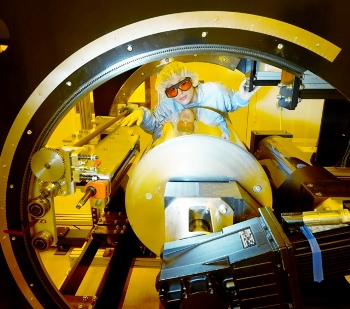Jan 21 2016
INM – Leibniz Institute for New Materials will present new nanoparticle inks, created using transparent, conductive oxides (TCOs), at the 2016 International Nanotechnology Exhibition and Conference (Nano Tech) in Tokyo, Japan. The nanoparticle inks are capable of providing cost-efficient, patterned, conductive, and transparent coatings for flexible touchscreens.
 One-step printing process provides cost-efficient conductive coatings for flexible touchscreens; Copyright: Uwe Bellhäuser,
One-step printing process provides cost-efficient conductive coatings for flexible touchscreens; Copyright: Uwe Bellhäuser,
Current smart phones and mobile phones have not been adapted to meet the carrying habits of its users. This is evident when a user tries to sit down with a mobile phone in their back pocket, the displays of pods and phones are not flexible and cannot bend according to the anatomical forms of the users.
The leading players in the industry are now working to create the first flexible displays. At Nano Tech, INM will demonstrate the method used to create the coatings suitable for this purpose.
The nanoparticle inks are appropriate for a single-step printing process on thin plastic foils. Transparent lines and patterns are obtained using direct gravure printing, which retain their electrical conductivity after bending.
Generally, high vacuum methods such as sputtering are used to apply conductive coatings with TCOs. Supplementary process steps such as photolithography and etching are required for patterning of the TCO coatings. These methods are expensive compared to a one-step printing method, which is made possible with the new TCO inks.
We use the TCOs to produce nanoparticles with special properties. The TCO ink is then created by adding a solvent and a special binder to these TCO particles.
Peter William de Oliveira, Head of the Optical Materials Program Division
The binder does not only enable the TCO nanoparticles to stick well on the film, it also enhances the flexibility of the TCO coating, retaining the conductivity despite the film being bent. Using gravure printing and a printing plate, the ink can be coated directly on to the film. The coating is ready after being cured under a UV light, at temperatures below 130°C.
Conductor tracks can be produced without any hassle by the transparent electronic inks, even in large-scale production using the standard reel-to-reel method.
The preliminary trials conducted at INM have proved to be promising. The team believe that using structured rollers will allow printing of large, structured conductive surfaces with a high throughput in an inexpensive manner.
The INM research team will be showcasing its results at the German Area, Booth 5J - 17 between 27 and 29 January.